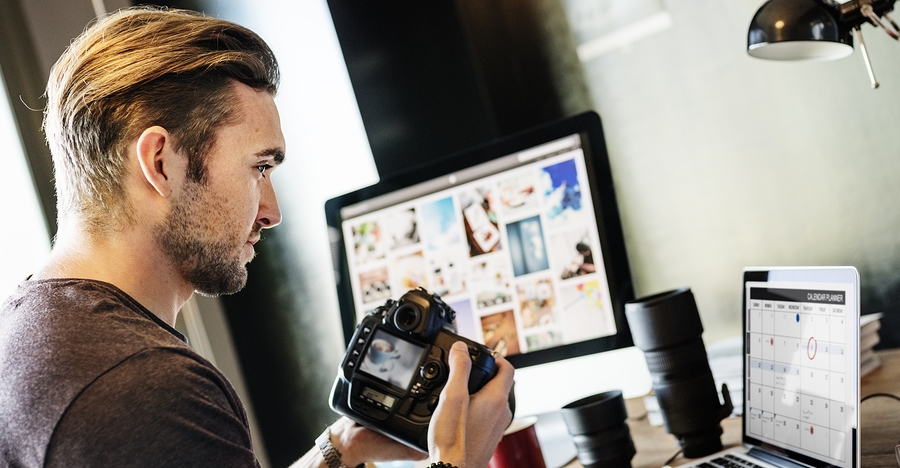You could always just store your images in external hard drives but there is no point in that when you can make things so much easier.
Jason D. Little over at Light Stalking wrote about the features of different photo sharing site that can help you with your photography business. We picked our favorite 3 – any one of these sites can help you with storage issues. They will also give you a place to showcase your images in a very professional way, and help you sharing them with family, friends and clients.
Flickr
Established in 2004, Flickr remains a top brand in the photo sharing market despite some of the changes that have occurred since its acquisition by Yahoo! Generally, Flickr is a flexible, easy to use service.
While it bills itself primarily as a photo sharing community, Flickr does provide useful options for those seeking to use the site to store images (you can organize photos into sets and collections). Editing features such as cropping, tonal adjustments and red-eye removal are built into the platform; you also have the ability to geotag photos, join groups and create print projects.
Perhaps the most impressive thing is you get 1TB of free storage; that’s about 500,000 photos. Yep, you can store half a million photos for free. Furthermore, the maximum size of each photo you upload is a whopping 200MB (videos can be up to 1GB or 3 minutes long). Images can also be downloaded and uploaded in their native resolution.
Flickr does offer two paid plans. The $6USD per month/$50USD per year plan simply removes all ads from the free plan. The $500USD plan gives you 2TB of storage.
Bottom Line: If you want to engage with a socially active photo sharing community and want to a good degree of flexibility for organizing the files you upload, Flickr is the place for you.
500px
500px was for a long time Flickr’s stiffest competition. Based on a similar blueprint as Flickr, 500px bills itself as “a photo community for discovering, sharing, buying and selling inspiring photography powered by creative people worldwide.”
500px does offer plenty of groups where members can interact with one another, though group participation doesn’t appear to be as robust as Flickr. There are apps for iOS and Android that let you conveniently upload images, or you can upload via the website (a simple drag-and-drop process that facilitates batch uploads of 10 files at a time).
Additionally, you can import photos from other services like Flickr, Google and Dropbox or use a plugin to upload images directly from Lightroom. All photos are initially placed in your Library.
One of the standout features of 500px is its Portfolios; they are beautifully designed and offer numerous customization options (though you will need a paid subscription to take full advantage of the personalized portfolio).
500px’s basic plan is free and allows 20 uploads a week. The Plus plan gives you unlimited uploads for $25USD per year. The Awesome plan, which gives you access to a personalized portfolio in addition to unlimited uploads, will cost you $75USD per year.
For $165USD per year, you can get the Awesome + Adobe plan, which includes everything in the Awesome plan plus a subscription to the Adobe Creative Cloud Photography plan (Photoshop CC, Lightroom, Lightroom Mobile).
Bottom Line: 500px users tend to share only their very best work; it is far more portfolio-oriented than Flickr. If you’re looking for an elegantly designed platform to showcase (and possibly monetize) your work, 500px is for you.
Google Photos
Google took its Google+ platform, shook it up a little bit and out came Google Photos. Google Photos revolves around a website and a mobile app (available for Android and iOS) to make uploading your images and videos a breeze.
The app will automatically upload any new photo or video you take with your device; you can use the website to drag and drop files or use the Google Photos Backup desktop app to automatically upload files from any folder you designate.
Google Photos then takes your uploads and gives them the royal treatment, magically creating stylized photos, slideshows, GIFs, albums based on a particular location or event (and other cool works of automated art).
Simply sign up for a Google account and all these features are yours for free. But — of course there is a but — if you upload photos with resolution greater than 16 megapixels, Google Photos is going to compress those files.
This may not matter to some users, but if you don’t want Google to compress your images there is an option to upload original resolution images using the 15GB of storage that is included with your basic Google account. If you need more space $1.99USD per month will get you 100GB, while $9.99USD per month will get you 1TB.
Bottom Line: If you crave automation — from uploading/backups to stylization to organization, there’s no better solution than Google Photos.
Read the full article with more tips over at Light Stalking.
Source: Light Stalking

